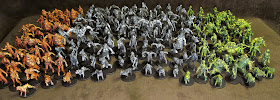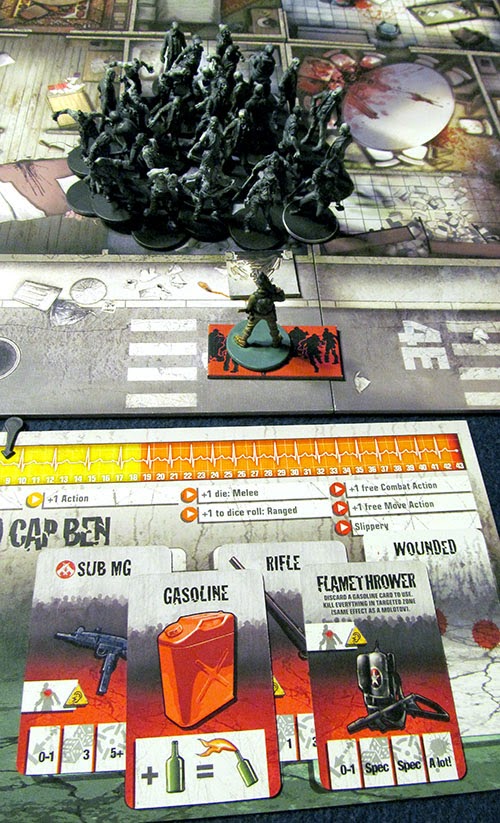 |
| The first five. I took my time with these, maybe about an hour total. |
I've noticed a few of you wanting to paint your zombies using the monochromatic style. I just have a couple notes to add: The first five that I painted, I took my time on, imagining the colors and their gray equivalents, and took my time to brush on the paint. Those first five came out great.
 |
| ... And the remaining 200 figures only took 4 to 6 hours. |
But the remaining 200 zombies, I mostly drybrushed, roughly picking out details here and there (faces, white shirts, black ties) with a smaller brush. It's difficult to see in the horde photo, but the quality of paint is not as good as my original prototypes. BUT, all together, the effect is still the same; that wave of gray zombies still has the effect of a retro zombie apocalypse movie (not that Romero ever had herds and hordes as big as those seen in Walking Dead and World War Z), but with the monochrome, they seem to almost glow as a massive collective.
 |
| My first (and still favorite) monochromatic project. Copplestone gangsters. |
I just wanted to bring this up in case you're painting your monochromatic zombies, and they're not looking as good as you had hoped. Keep it up -- the effect is not meant for individual figures, but for the crowd in its entirety. You can still take your time painting each individual zombie (and I think the look really is rewarded when you exercise patience), but slow or fast, the point is to enjoy what you're doing.
Adding color
If you want to see a black and white collection that was painted with love and patience, I recommend you take a look at this beautiful
WWI collection at Analogue Hobbies. As well as painting everything in the monochrome style, Curt has picked out leader figures by adding a little bit of color, painting keppies with a slightly muted red for the French, for example.
If you add color, I recommend muting that color so that it fits the general scheme. Now, of course, it's difficult to mute a good "blood" color, so take this advice with a grain of salt; if the blood looks best bright, glossy and oozing, by all means, leave it as so.
I plan on doing my VIP zombies in grayscale, but to differentiate them from the standard grays, I will be adding blood. I'm not sure if I'll go mute or bold, though.
A little battle report
 |
Just before the final action of the game.
Yes, the walkers are all in one room. |
I played a quick solo game, playing the mission, "Under Siege" (C2.) I had Red Cap Ben, Padre Johnson, Gary and Ralph (I call this group my "Hobo Strike Force.")
I used the Romero deck to keep things somewhat sane. Even still, it got out of hand fast. just a few turns in, I lost the Padre, Ralph and Gary in consecutive turns. (I know, game over, but I wanted to see how long Ben could go.)
Before Gary bit the dust, he managed to clear an adjacent room with his submachine gun, giving Ben an escape path. Ben was able to stay just ahead of the growing hordes, though, once the spawning ended, he was able to gain some space after a little bit of running around. Finally he got a chance to search a room and found a nice present-- and he already had the gasoline.
Yes, in the photo, all of those zombies are in one room. This is just before the last action of the game. (Yes, technically the survivors lost, but Ben still had fun.)
Even though I lost, I think the game was a bit tilted in my favor; the mission is meant to be played with more spawn cards than the Romero deck (mine is about 25 cards.) I'll wait until I get a group of 5 or 6 before tackling this one again.














